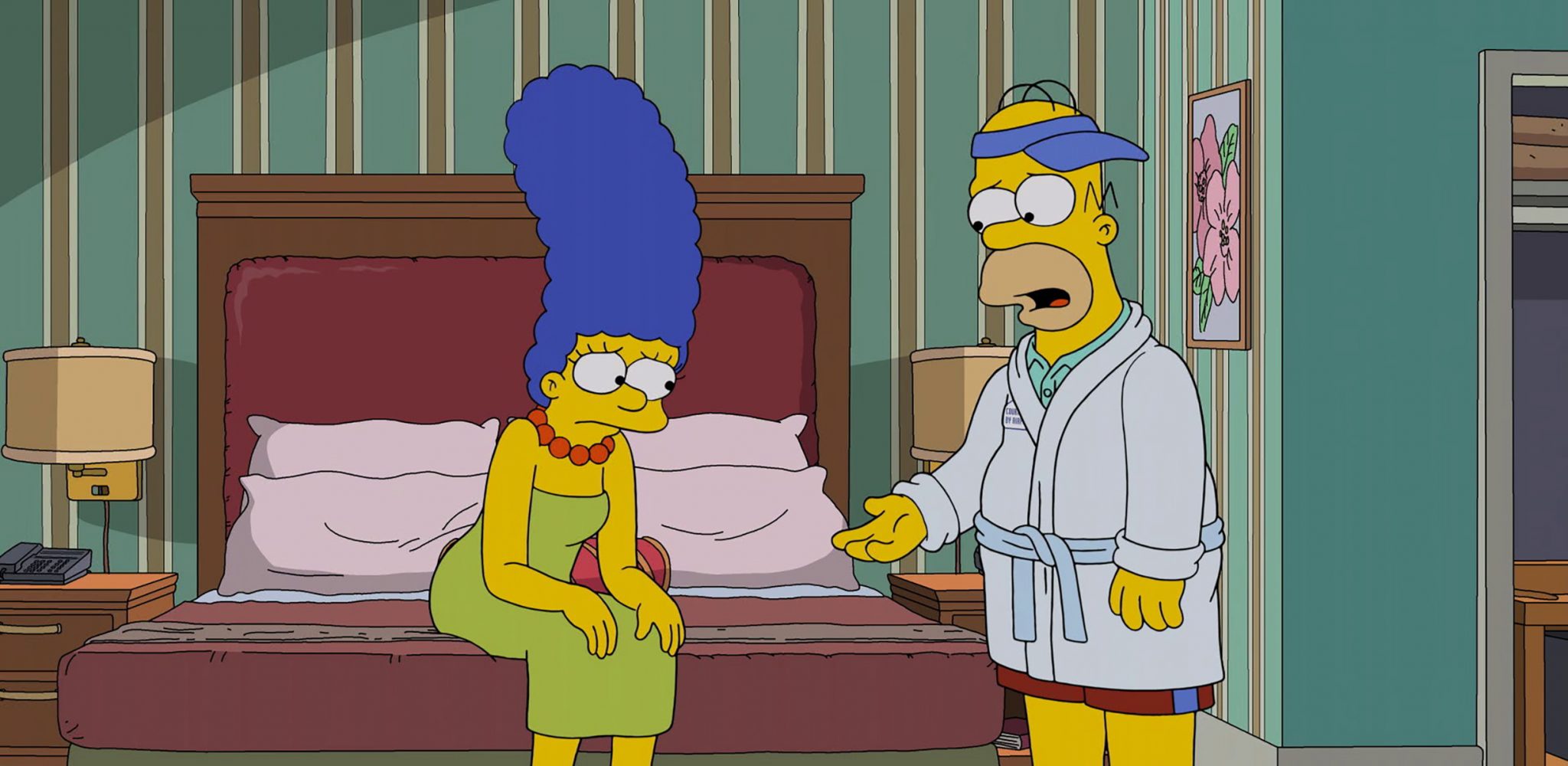In Amia Srinivasan’s The Right to Sex, the philosopher lays out a world that is too bad for anyone to actually, wholeheartedly and unapologetically, have it
In the opening scenes of The Simpsons episode ‘Grampa vs. Sexual Inadequacy’ (1994) – the one where Homer and Grampa start selling the aphrodisiac medicine Grampa cooks up in his bathtub – Homer and Marge are having some ‘marital difficulties’: they keep trying, but then failing, to have sex. “Marge,” Homer explains, “there’s just too much pressure. What with my job, the kids, traffic snarls, political strife at home and abroad. But I promise you, the second all those things go away…we’ll have sex.”
If there is a moment, a line, where Homer Simpson’s star comes into alignment with that of Amia Srinivasan, who is at the age of 36 already the Chichele Professor of Social and Political Theory at All Souls College, Oxford, successor to such titans of political philosophy as G.A. Cohen, Charles Taylor, and Isaiah Berlin – then it is here. Srinivasan’s first book, The Right to Sex (2021), is an essay collection about – well, obviously – sex. But it’s really about why the world is too bad for anyone to actually, wholeheartedly and unapologetically, have it.
Srinivasan is one of those philosophers who is, first and foremost, an exceptional prose stylist – an exemplar of what academic writing, specifically, both could and should be. Her writing is unadorned and perfectly-tuned, like listening to someone play the piano incredibly well: at times her sentences resonate with an almost luminous clarity, reducing some horrendously tangled rat-king of philosophical concepts and material concerns to an insight which beams out perfectly in the relations between her paragraphs. Just take the book’s opening sentences, for instance, which crystallise a difficulty that could well merit a lifetime of study, while also taking a determined stance on that difficulty for itself:
‘Feminism is not a philosophy, or a theory, or even a point of view. It is a political movement to transform the world beyond recognition. It asks: what would it be to end the political, social, sexual, economic, psychological and physical subordination of women? It answers: we do not know; let us try and see.’

Srinivasan has already scaled the professional heights of established, Oxford, analytic philosophy. Despite this, her book rubs against the grain of this way of doing philosophy – in more ways than one. Unlike most analytic philosophy, Srinivasan’s book is angry – icily calm and clear, yes; at times almost terrifyingly restrained; righteously and appropriately angry – but angry, nonetheless. Angry about a world in which sex is, in short, a site of unfreedom: of rape; of the carceral state, which disproportionately punishes marginalised women for the crimes of more powerful men; of ‘incel’ mass shootings; of abusive teacher-student relationships; of the pornography both boys and girls turn to in lieu of decent sex education, which they themselves believe has marked them with the wrong desires for life. For all Srinivasan despairs of any efforts to police desire by means of the law, she nevertheless believes – contra to the likes of the trans feminist theorist Andrea Long Chu, whose pioneering essay ‘On Liking Women’ asserts the essential irrationality of desire – that our desires are apt for effective moral and political critique. ‘I was not imagining a desire regulated by the demands of justice,’ she writes at one point, ‘but a desire set free from the binds of injustice.’
‘What would it take for sex really to be free?’ Srinivasan asks in the ‘Preface’ to her book. ‘We do not yet know; let us try and see.’ And here, really, is the second way in which The Right to Sex is unlike the vast majority of analytic philosophy. Most analytic philosophy, ultimately, is looking for good grounds to justify what everyone already thinks they know – or at least, the ‘intuitions’ of the philosopher themselves and most of their colleagues. Srinivasan, on the other hand, is at most trying to help us ask better questions. ‘In these essays I attempt to dwell,’ she writes herself, ‘in discomfort and ambivalence. These essays do not offer a home.’ Her moralistic approach to sex, she realises, is likely to be experienced by many as highly unwelcome – as is her almost total unwillingness to contemplate carceral solutions to things like sex work (by criminalising male customers) or indeed male sexual violence in general. A recent Guardian profile closed with Srinivasan’s interviewer exclaiming ‘Crikey’ at her subject’s inclusive stance on trans people, accusing her of ‘drinking the Kool-Aid that is Judith Butler, high priestess of gender theory,’ and then fuming off to eat some chocolate to alleviate the ache caused by the size of Srinivasan’s big boffiny show-off brain.
Srinivasan’s feminism is ultimately utopian – her analysis never seeks to reconcile itself to a world which is anything other than finally, universally free. In this, The Right to Sex is an almost uniquely unedifying book. Its effect is not to leave the reader feeling confident and optimistic and sure of what is to be done, but rather to catch a glimpse of the horrible severity of reality, as Srinivasan sees it. In a way, she writes like Nietzsche (though with a lot less storm and stress): the point here is to undo you; you’re going to have to build yourself back up. (It would be possible here to complain about a lack of answers, of course – but if none present themselves from the armchair, I really don’t see why philosophers should be in the business of trying to dream them up – better to save the space, and give it to the reader, both to think and act).
I have my problems with the book – though they’re in a way too nit-picky to really give a comprehensive treatment of here. There were points, for instance, when I felt Srinivasan let herself have things too easy: borrowing from the porn star Stoya what is essentially an ideal model of what ‘mainstream’ internet porn consists in, for example (‘where hot blondes suck dicks, get fucked hard, told that they like it, and end up with semen on their face’), in order to critique her male students’ desires, as if this is what all heterosexual men are into, almost as a matter of definition. But this fails, I feel, to account for what internet porn sites actually expose otherwise unsuspecting teens to. Is it really possible to first log on to Pornhub, as a young teen, and not feel overwhelmed by the site’s array of once truly outré paraphilias, beamed directly to your virgin eyes? Are anyone’s desires – formed through porn, or whatever – in truth all that ‘normal’? In general I felt that Srinivasan was much more interested in encouraging feminist women to critique their own desires, than in thinking properly deeply (and openly, and ambivalently) about male heterosexual desire: this is after all a work about relations between the sexes, so it would have been nice to see male heterosexual desire treated as something much less univocal than how it appears here.

Relatedly: I also think it’s important to question Srinivasan’s reading of the ‘incel’ mass killer Elliot Rodger, with whose memoir-manifesto ‘My Twisted World’ I happen to share a morbid fascination (according to Srinivasan, the essay which provided the seed for the book began life as a close reading of ‘My Twisted World’). Srinivasan’s take on Rodger is that other commentators, though perhaps understandably (given the nature of his crime), downplayed the feelings of inferiority, both racial (Rodger was half-Asian, but also an avowed white supremacist) and in terms of his masculinity (Rodger was small, clumsy, and effeminate) that plagued him his whole life. They didn’t justify Rodger’s crime – of course not. But they must nevertheless lead us to ask: who wants to fuck who; who gets to fuck who – and why?
For me though, the really interesting question that Rodger’s manifesto raises is a rather different one. When I’ve read Rodger’s memoir, the thing I’ve been most struck by is how little – especially for someone who committed murder, ostensibly because he was denied the ‘right to sex’ – he actually appeared to want sex with anyone at all. Throughout ‘My Twisted World’, Rodger testifies to the ways in which he feels literally, physically tortured by the institutions and practices of heterosexual desire, which he believes to have robbed him of his boyhood dream of fitting in with the all-American white boys who were bigger, fitter, and more popular than him at his California private schools. By age 11, Rodger feels, he has just about mastered the trick: but then puberty hits, and now everything hinges not on playing the right video games, or owning a skateboard, but on being able to get a girlfriend – and he is back to square one again. A girl pushes him at summer camp, and he becomes terrified of women – he is pushed to the point of a years-long private breakdown.
At no point in his memoir does Rodger make any direct attempt to hit on a woman – at most he just hangs around in cafes, then complains about women ‘rejecting’ him when they don’t approach him themselves. Much more of ‘My Twisted World’ is devoted to Rodger’s attempts to win the lottery, than to sleep with any real, human women. As Srinivasan does in fairness note, he is mainly interested in having a girlfriend so that he can have ‘status’ in the eyes of other men (which is why his preferred women are tall and blonde): in his wildest, most megalomaniac fantasies, Rodger does not force women to fall in love with him, but rather kills most of them, keeps a few locked up as breeders (artificially inseminated, naturally), then hides knowledge of their existence from all other men – so that his all-male society can exist harmoniously, unsullied, in-itself. Rodger, in short, wasn’t really interested in the right to sex: he was an extreme, violent, sex abolitionist.
This must lead us to ask, if we are here in the business of critiquing desire in general – must we then assume that desire is always, as it were, what it says it is? Or can there be a sort of negative desire: a seeming desire for the thing, that is grounded in never wanting to have to bother with it in the first place? And in our world of alienating, empathy-less, pornoified, bureaucratised bad sex… is this perhaps true of most, if not all, sexual desire?
This is the central question I was left with after finishing The Right to Sex. If Srinivasan is right about how bad sex is, under presently-existing conditions, then really: who would ever want to have it at all? And yet to this theoretical problem, I already have, ready-to-hand, a practical response. I am not a confused teenager anymore, or an academic who likes to sleep with his students: I am an adult man, who sleeps (as it were) in a big bed with his wife. In Homer and Marge’s relationship, yes, at least in that one scene, political struggles enter the bedroom, and make good sex impossible – but Homer and Marge, let’s face it, have a generally quite terrible marriage (they really wouldn’t be together, unless they had to stay together for the sake of the show). Sex may well be an appropriate site for moral and political critique. But there are times when, let’s face it, none of that can possibly feel like it matters. Real, good sex can only be experienced as a zone of reprieve.
Amia Srinivasan, The Right to Sex, 2021, Bloomsbury
